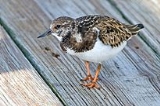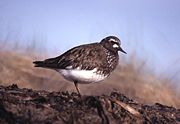
Turnstone
Encyclopedia
Turnstones are the bird species
in the genus
Arenaria in the family
Scolopacidae
. They are closely related to calidrid
sandpipers and might be considered members of the tribe
Calidriini.
Both birds are distinctive medium-sized wader
s. They are high Arctic
breeders, and are migratory
. These chunky powerful birds have strong necks and bills well suited to their feeding technique. As the name implies, these species readily turn stones or seaweed looking for hidden invertebrate
s. They are strictly coastal, preferring stony beaches to sand, and are often found with other waders such as Purple Sandpiper
s.
Their appearance is striking in flight, with white patches on the back, wings and tail.

 The Ruddy Turnstone
The Ruddy Turnstone
(or just Turnstone in Europe
), Arenaria interpres, has a circumpolar distribution, and is a very long distance migrant, wintering on coasts as far south as South Africa
and Australia
. It is thus a common sight on coasts almost everywhere in the world.
In breeding plumage
, this is a showy bird, with a black-and-white head, chestnut back, white underparts and red legs. The drabber winter plumage is basically brown above and white below.
This is a generally tame bird and is an opportunist feeder. Unlike most waders, it will scavenge, and has a phenomenal list of recorded food items, including human corpses and coconut
.
The call is a staccato tuck- tuck- tuck.
The Ruddy Turnstone is one of the species to which the Agreement on the Conservation of African-Eurasian Migratory Waterbirds (AEWA
) applies.
The Black Turnstone
(Arenaria melanocephala) has a similar structure to its widespread relative, but has black upperparts and chest, and white below. It has a much more restricted range than the Ruddy Turnstone, breeding in western Alaska
, and wintering mainly on the Pacific
coast of the USA
.
There exists a fossil
bone, a distal piece of tarsometatarsus
found in the Edson Beds of Sherman County, Kansas
. Dating from the mid-Blancan
some 4-3 million years ago, it appears to be from a calidriid somewhat similar to a Pectoral Sandpiper
, but has some traits reminiscent of turnstones. Depending on which traits are apomorphic and plesiomorphic, it may be an ancestral representative of either lineage.
Species
In biology, a species is one of the basic units of biological classification and a taxonomic rank. A species is often defined as a group of organisms capable of interbreeding and producing fertile offspring. While in many cases this definition is adequate, more precise or differing measures are...
in the genus
Genus
In biology, a genus is a low-level taxonomic rank used in the biological classification of living and fossil organisms, which is an example of definition by genus and differentia...
Arenaria in the family
Family (biology)
In biological classification, family is* a taxonomic rank. Other well-known ranks are life, domain, kingdom, phylum, class, order, genus, and species, with family fitting between order and genus. As for the other well-known ranks, there is the option of an immediately lower rank, indicated by the...
Scolopacidae
Scolopacidae
The sandpipers are a large family, Scolopacidae, of waders or shorebirds. They include many species called sandpipers, as well as those called by names such as curlew and snipe. The majority of these species eat small invertebrates picked out of the mud or soil...
. They are closely related to calidrid
Calidrid
The calidrids or typical waders are a group of Arctic-breeding, strongly migratory wading birds. These birds form huge mixed flocks on coasts and estuaries in winter. They are the typical "sandpipers", small to medium-sized, long-winged and relatively short-billed.Their bills have sensitive tips...
sandpipers and might be considered members of the tribe
Tribe (biology)
In biology, a tribe is a taxonomic rank between family and genus. It is sometimes subdivided into subtribes.Some examples include the tribes: Canini, Acalypheae, Hominini, Bombini, and Antidesmeae.-See also:* Biological classification* Rank...
Calidriini.
Both birds are distinctive medium-sized wader
Wader
Waders, called shorebirds in North America , are members of the order Charadriiformes, excluding the more marine web-footed seabird groups. The latter are the skuas , gulls , terns , skimmers , and auks...
s. They are high Arctic
Arctic
The Arctic is a region located at the northern-most part of the Earth. The Arctic consists of the Arctic Ocean and parts of Canada, Russia, Greenland, the United States, Norway, Sweden, Finland, and Iceland. The Arctic region consists of a vast, ice-covered ocean, surrounded by treeless permafrost...
breeders, and are migratory
Bird migration
Bird migration is the regular seasonal journey undertaken by many species of birds. Bird movements include those made in response to changes in food availability, habitat or weather. Sometimes, journeys are not termed "true migration" because they are irregular or in only one direction...
. These chunky powerful birds have strong necks and bills well suited to their feeding technique. As the name implies, these species readily turn stones or seaweed looking for hidden invertebrate
Invertebrate
An invertebrate is an animal without a backbone. The group includes 97% of all animal species – all animals except those in the chordate subphylum Vertebrata .Invertebrates form a paraphyletic group...
s. They are strictly coastal, preferring stony beaches to sand, and are often found with other waders such as Purple Sandpiper
Purple Sandpiper
The Purple Sandpiper, Calidris, Arquatella or Erolia maritima is a small shorebird.Adults have short yellow legs and a medium thin dark bill with a yellow base. The body is dark on top with a slight purplish gloss and mainly white underneath. The breast is smeared with grey and the rump is black...
s.
Their appearance is striking in flight, with white patches on the back, wings and tail.


Ruddy Turnstone
The Ruddy Turnstone is a small wading bird, one of two species of turnstone in the genus Arenaria. It is now classified in the sandpiper family Scolopacidae but was formerly sometimes placed in the plover family Charadriidae...
(or just Turnstone in Europe
Europe
Europe is, by convention, one of the world's seven continents. Comprising the westernmost peninsula of Eurasia, Europe is generally 'divided' from Asia to its east by the watershed divides of the Ural and Caucasus Mountains, the Ural River, the Caspian and Black Seas, and the waterways connecting...
), Arenaria interpres, has a circumpolar distribution, and is a very long distance migrant, wintering on coasts as far south as South Africa
South Africa
The Republic of South Africa is a country in southern Africa. Located at the southern tip of Africa, it is divided into nine provinces, with of coastline on the Atlantic and Indian oceans...
and Australia
Australia
Australia , officially the Commonwealth of Australia, is a country in the Southern Hemisphere comprising the mainland of the Australian continent, the island of Tasmania, and numerous smaller islands in the Indian and Pacific Oceans. It is the world's sixth-largest country by total area...
. It is thus a common sight on coasts almost everywhere in the world.
In breeding plumage
Plumage
Plumage refers both to the layer of feathers that cover a bird and the pattern, colour, and arrangement of those feathers. The pattern and colours of plumage vary between species and subspecies and can also vary between different age classes, sexes, and season. Within species there can also be a...
, this is a showy bird, with a black-and-white head, chestnut back, white underparts and red legs. The drabber winter plumage is basically brown above and white below.
This is a generally tame bird and is an opportunist feeder. Unlike most waders, it will scavenge, and has a phenomenal list of recorded food items, including human corpses and coconut
Coconut
The coconut palm, Cocos nucifera, is a member of the family Arecaceae . It is the only accepted species in the genus Cocos. The term coconut can refer to the entire coconut palm, the seed, or the fruit, which is not a botanical nut. The spelling cocoanut is an old-fashioned form of the word...
.
The call is a staccato tuck- tuck- tuck.
The Ruddy Turnstone is one of the species to which the Agreement on the Conservation of African-Eurasian Migratory Waterbirds (AEWA
AEWA
The Agreement on the Conservation of African-Eurasian Migratory Waterbirds is the largest of its kind developed so far under the Bonn Convention. It was concluded on 16 June 1995 at The Hague, the Netherlands and entered into force on 1 November 1999 after the required number of at least fourteen...
) applies.
The Black Turnstone
Black Turnstone
The Black Turnstone is a species of small wading bird. It is one of two species of turnstone in the genus Arenaria, the Ruddy Turnstone being the other. It is now classified in the sandpiper family Scolopacidae but was formerly sometimes placed in the plover family Charadriidae...
(Arenaria melanocephala) has a similar structure to its widespread relative, but has black upperparts and chest, and white below. It has a much more restricted range than the Ruddy Turnstone, breeding in western Alaska
Alaska
Alaska is the largest state in the United States by area. It is situated in the northwest extremity of the North American continent, with Canada to the east, the Arctic Ocean to the north, and the Pacific Ocean to the west and south, with Russia further west across the Bering Strait...
, and wintering mainly on the Pacific
Pacific Ocean
The Pacific Ocean is the largest of the Earth's oceanic divisions. It extends from the Arctic in the north to the Southern Ocean in the south, bounded by Asia and Australia in the west, and the Americas in the east.At 165.2 million square kilometres in area, this largest division of the World...
coast of the USA
United States
The United States of America is a federal constitutional republic comprising fifty states and a federal district...
.
There exists a fossil
Fossil
Fossils are the preserved remains or traces of animals , plants, and other organisms from the remote past...
bone, a distal piece of tarsometatarsus
Tarsometatarsus
The tarsometatarsus is a bone that is found in the lower leg of certain tetrapods, namely birds.It is formed from the fusion of several bones found in other types of animals, and homologous to the mammalian tarsal and metatarsal bones...
found in the Edson Beds of Sherman County, Kansas
Sherman County, Kansas
Sherman County is a county located in the U.S. state of Kansas. As of the 2010 census, the county population was 6,010...
. Dating from the mid-Blancan
Blancan
The Blancan North American Stage on the geologic timescale is the North American faunal stage according to the North American Land Mammal Ages chronology , typically set from 4,750,000 to 1,808,000 years BP, a period of .. It is usually considered to start in the early-mid Pliocene epoch and end...
some 4-3 million years ago, it appears to be from a calidriid somewhat similar to a Pectoral Sandpiper
Pectoral Sandpiper
The Pectoral Sandpiper, Calidris melanotos, is a small wader. It is sometimes separated with the "stint" sandpipers in Erolia. This may or may not represent a good monophyletic group, depending on the placement of the phylogenetically enigmatic Curlew Sandpiper , the type species of Erolia...
, but has some traits reminiscent of turnstones. Depending on which traits are apomorphic and plesiomorphic, it may be an ancestral representative of either lineage.
External links
- Ruddy Turnstone - Cornell Lab of Ornithology
- Ruddy Turnstone Arenaria interpres - USGS Patuxent Bird Identification InfoCenter
- Ruddy Turnstone Information - South Dakota Birds and Birding
- Turnstones feeding and bathing

